![]()
![]()
![]()
Use LEFT and RIGHT arrow keys to navigate between flashcards;
Use UP and DOWN arrow keys to flip the card;
H to show hint;
A reads text to speech;
61 Cards in this Set
- Front
- Back
|
Independent variable |
The variable we change on purpose because it's the factor we are testing, the variations we know going into the experiment. |
|
|
Dependent variable |
The factor that changes depending on the independent variable; the data we collect. |
|
|
Control |
The standard used for comparison in test results; a part of the experiment that is not varied. |
|
|
Constants |
All the factors that are held the same between the test subjects. |
|
|
Qualitative Data |
1. Descriptive 2. Things that are heard to meaure, such as color, texture or smell 3. Might be subjective |
|
|
Quantitative Data |
1. Data that can be measured Ike length, volume, temperature, age, etc. 2. Usually objective. |
|
|
Claim |
A statement that answers the question or problem, a conclusion you are drawing based on evidence. |
|
|
Evidence |
Data that supports your claim. |
|
|
Reasoning |
Explains why- why we observed those results, why we had that data, why did that happen... what's the science? |
|
|
Diffusion |
The movement of a substance from areas of highconcentration, to areas of low concentration, until equilibrium is reached.
|
|
|
Osmosis |
The diffusion of water. depends on the relative concentration of solute molecules on either side of the membrane. |
|
|
Tonicity |
Refers to how concentrated a solution isrelative to a cell
|
|
|
Hypertonic |
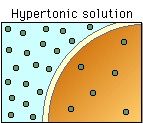
The solution outside the cell is more concentrated withsolutes than the inside of the cell.
|
|
|
Hypotonic |
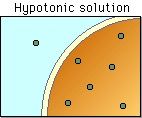
The solution outside the cell is less concentrated withsolutes than the inside of the cell.
|
|
|
Isotonic |
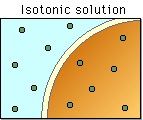
The solution outside the cell has the same concentration as the inside of thecell.
|
|
|
Active Transport |
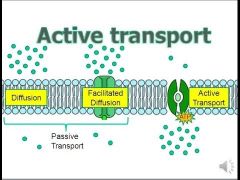
Uses energy to move a solute “uphill” against its gradient.
|
|
|
Facilitated Diffusion |
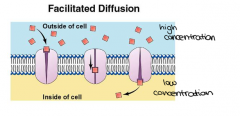
In facilitated diffusion, a solute moves down its concentration gradient and no energy input is required.
|
|
|
Passive Transport: cell membrane pumps |
Pump molecules up the concentrationgradient (low to high concentration).
|
|
|
Endocytosis |
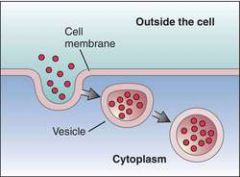
Cell membrane pinches off -transports many molecules into cell at thesame time.
|
|
|
Phagocytosis |
When a cell "devours" a solid particle. |
|
|
Exocytosis |
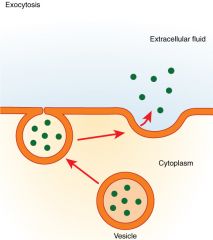
Cell membrane pinches off to export many molecules out of the cell at the same time.
|
|
|
Three critical things that DNA molecules must do
|
1. They have to carry information from one generation to the next. 2. They have to put that information to work by determining the heritable characteristics of organisms. 3. Genes had to be easily copied, because all of a cell's genetic information is replicated every time a cell divides. |
|
|
Nucleotide |
DNA is a long molecule made up of units called nucleotides.
|
|
|
DNA Backbone |
Is formed by sugar and phosphate groups of each nucleotide. The nitrogenous bases stick out sideways from the chain. The nucleotides can be joined together in order, meaning that any sequence of bases is possible.
|
|
|
Chargaff's Rules |
The fact that in almost any DNA sample the percentage of cytosine and guanine was almost equal. The rule- g=c and a=t.
|
|
|
Prokaryotes |
Prokaryote's DNA is in the cytoplasm. They usually have a single circular DNA molecule that contains nearly all of the cell's genetic information. That is usually referred to as the cell's chromosome. Unicellular.
|
|
|
Eukaryotes |
Eukaryotes have as much as 1000 times the amount of DNA as prokaryotes. Their DNA is not in the cytoplasm, but generally in the nucleus, in the form of a number of chromosomes. Number of chromosomes varies widely, from one species to the next.
|
|
|
Chromosome Structure |
Chromatin- Eukaryotic chromosomes contain both DNA and protein tightly packed together to form a substance called chromatin. Chromatin consists of DNA that is tightly coiled around proteins called, histones. Histones- Chromatin consists of DNA that is tightly coiled around proteins called, histones. Together, DNA and histone molecules form a beadlike structure called a nucleosome. |
|
|
Eukaryotic DNA Replication |
It occurs at hundreds of places. Replication proceeds in both directions until each chromosome is completely copied. The sites where separation and replication occur are called replication forks.
|
|
|
DNA Duplication: Replication |
Before a cell divides, it duplicates its DNA in a copying process called replication. This process ensures that each resulting cell will have a complete set of DNA molecules. During DNA replication, the DNA molecule separates into two strands, then produces two new complementary strands following the rules of base pairing. Each strand of the double helix of DNA serves as a template, or model, for the new strand.
|
|
|
Duplicating DNA: Enzymes |
DNA replication is carried out by a series of enzymes. These enzymes "unzip" a molecule of DNA. The unzipping occurs when the hydrogen bonds between the base pairs are broken and the two strands of the molecule unwind. Each strand serves as a template for the attachment of the complementary bases.
|
|
|
Duplicating DNA: DNA Polymerase |
The principal enzyme involved in DNA replication is called DNA polymerase because it joins individual nucleotides to produce a DNA molecule, which is, of course, a polymer. DNA polymerase also "proof reads" each new DNA strand, helping to maximize the odds that each molecule is a perfect copy of the original DNA.
|
|
|
What is the goal of protein synthesis? Why is this important in our cells?
|
To make proteins. Proteins allow our bodies to perform certain functions.
|
|
|
Short summary of transcription |
The DNA unzips itself, by DNA polymerase, and a single stranded mRNA copies one side of the DNA codons.
|
|
|
How does a 3 meter strand of DNA fit into a tiny cell?
|
It is packaged into compact units called chromosomes. It starts with the double helix of the DNA, which then wraps around some proteins. The proteins are packed tightly together until they form a chromosome.
|
|
|
Macromolecules |
"Giant molecules" made up of many, many smaller molecules. |
|
|
Monomers |
Small molecules |
|
|
Polymers |
Strands of smaller molecules put together. The result of ploymerization. |
|
|
Polymerization |
Where small molecules join to together to form bigger molecules. |
|
|
What are carbohydrates made of? |
Carbon, oxygen, hydrogen. |
|
|
What are lipids made of? |
Fatty acids and glycerol. |
|
|
What are proteins made of? |
Carbon, oxygen, hydrogen and nitrogen. COHN |
|
|
What are nucleic acids made of? |
Carbon, oxygen, hydrogen, nitrogen and phosphorus. PHONC |
|
|
What do carbohydrates do? |
They are the main source of energy for living things. |
|
|
Monosaccharides |
Single sugar molecule |
|
|
Polysaccharides |
Large molecules formed by monosaccharides. |
|
|
Sugars |
Carbohydrates |
|
|
What do lipids do? |
They can be used to store energy and some lipids are important parts of biological matter. |
|
|
What do nucleic acids do? |
They store and transmit hereditary, or genetic information. |
|
|
What do proteins do? |
Some proteins control the rate of reactions and regulate cell processes. Some are used to form bones and muscles. Others transport substances into or out of cells or help to fight diseases. |
|
|
Nucleotides |
They consist of three parts: a 5-carbon sugar, a phosphate group, and a nitrogenous base. Individual nucleotides can be joined by covalent bonds to form a polynucleotides or nucleic acid. |
|
|
Promoter region |
A specific place that RNA polymerase can only bond to. |
|
|
Polypeptides |
Chains of amino acids |
|
|
Amino Acid |
Proteins are polymers of molecules called amino acids that are essential for the body. |
|
|
Chromosomal mutations |
Changes in the number or structure of chromosomes. |
|
|
Catalyst |
A substance that speeds up the rate of a chemical reaction. |
|
|
Enzymes |
They are proteins that act as biological catalysts. (A substance that speeds up the rate of a chemical reaction.) Enzymes speed up chemical reactions that take place in cells. They provide a site where reactants can be brought together to react. |
|
|
Substrates |
The substance an enzyme acts on. The reactants of enzyme-catalyzed reactions are known as substrates. |
|
|
Enhancer Region |
It can bind to a particular gene and can increase the rate of transcription of that gene. |
|
|
Introns |
The DNA of eukaryotic genes contains sequences of nucleotides, called introns, that are not involved in coding for proteins. |
|
|
Exons |
The DNA sequences that code for proteins are called exons because they are "expressed" in the synthesis of proteins. |

